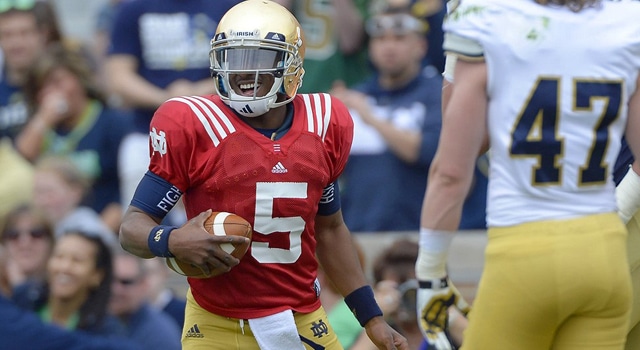

The whole, ideally, should be greater than the sum of the parts. But let’s start with “parts.”
OFFENSIVE LINE
Were Notre Dame to have corporate sponsors for units, Virginia Slims would seem the most appropriate for the offensive line: “You’ve come a long way baby!”
Right now, the line, from left to right appears to be LT Ronnie Stanley, LG Steve Elmer, C Nick Martin, RG Christian Lombard and RT Mike McGlinchey. Kelly said in mid-Spring that the McGlinchey/Hanratty tradeoff is a key decision, then later added that Matt Hegarty is a viable candidate for the left guard job. So it is conceivable that Elmer could be the right tackle (though both Kelly and Hiestand like the concept of lining up Elmer and Stanley next to each other) and either Hanratty or Hegarty the left guard.
But if the current (McGlinchey at RT) line holds that would leave fourth year players Hanratty and Hegarty as the top subs. Each has started and PROSPERED in the starting roles. This is more quality, experienced depth on the offensive line that our Irish have had in at least a decade.
But wait, there’s more! redshirt frosh Hunter Bivin and Colin McGovern each received praise this Spring and Kelly cited McGovern as one of Spring’s most pleasant surprises. Mark Harrell, who seems to be a squadman, and the massive mauler John Montelus, out last Fall with post-surgery recovery, are available for depth and emergency.
But wait, there is still more. In June, Quenton Nelson will arrive with 5 stars, a huge frame and a nasty attitude. He will be accompanied by Alex Bars, Sam Mustipher and the underrated Jimmy Byrne. Nelson has the credentials and physique to suggest that he might be as ready to contribute as Stanley was in 2012 and Elmer was last Fall
In 2012 the starting OL measured an average of 6’3 3/4, 305.4 lbs. The 2014 starting OL measures 6’6″ 311 lbs. We may not notice the difference, but opponent defensive lines will feel it.
Stanley, Elmer and McGlinchey appear to be “locks” to play in the NFL.
It looks like the Irish will have one of America’s 10 best offensive lines in 2014, despite losing the great Captain, Zach Martin, and the able Chris Watt. When you consider that only Christian Lombard exhausts his eligibility in 2014, and examine the assets in the pipeline, the top 10 OL status should maintain at least through 2017. If football does indeed begin in the trenches then let it begin with them!
WIDE RECEIVERS
Davaris Daniels, while absent, seems as repentant and resolved to return as Golson was. The Spring group is long on (gasp!) potential and confoundingly short on achievement. Chris Brown, 16 receptions, 1 TD, Will Fuller, 6 receptions and 1 TD, Corey Robinson, 9 receptions and 1 TD and CJ Prosise, 7 receptions, and no TDS. Each will be expected to produce at least 20 receptions and multiple TDS.
Chris Brown and Will Fuller have elite speed and Corey “Catch Radius” Robinson has elite, jaw-dropping hands. Corey seems quicker and more confident this Spring. Yet it is Torii Hunter Jr. whose ceiling may be the highest, at least if you catch Kelly’s hints.
The swift CJ Prosise in his second year at the position and he may be the best blocker in the unit. Amir Carlisle, slippery in space, appears to have found a home at slot. Freshman early entrant Justin Brent, whose body is ready has, to use Denbrock’s phrase, “been drinking water through a firehose” this Spring, but he won’t back down. He will probably play. Craftsman, technician Corey Holmes arrives in June.
This unit is like a hologram. turn it one way and you see the glaring lack of pelts on the wall. Turn it the other way and you see a position brimming with potential and depth. There is not a dud in the bunch. Not even Daniels exhausts his eligibility in 2014. All may be back. In 2012, Robby Toma, Daniel Smith and John Goodman were necessary and valuable contributors. In 2014, they would probably have a hard time overcoming anyone on the existing depth chart, and might, despite their noble and appreciated contributions, occupy the cellar.
NOTE ON DEPTH: At both: at both OL and WR, the senior Bell Cow, Lombard and Daniels, were unavailable for the Spring. But this program, this roster, has now matured and the depth exists to caulk over the gaps.
QUARTERBACKS
Ah, Golson. Slay the fatted calf: the prodigal has returned. Everett is older, wiser, bigger, better grasp of the playbook, tutored by George Whitfield. He may have been large part “kid” when he left but he’s more “man” now. We have seen this maturation before, when Browner, Fry, Bradley and Hunter returned after their “sabbatical.”
Everett has a big gun and is very accurate. He is not a great, explosive runner in the manner of Oregon’s Marcus Mariotta or John Manziel, but he is all that heaven allows when he leaves the pocket and starts looking, locating and lasering downfield. These are not “broken” plays they are “evolved” and “advanced” plays. Golson makes defensive coordinators gulp when they watch him improvise and orchestrate outside of the initial pocket. And he has enough running ability to instantly upgrades red zone efficiency by 20%. He is quick and agile enough to dash in to the end zone from inside the 10.
Certainly the point of emphasis is for Golson to remain in the pocket. Our line seems to no longer yield sacks. If Golson finally gets it on pocket discipline, it will make his excursions to the flanks even more devastating. Once again, we have no experienced backup. But Matt LaFleur had Kirk Cousins ready when the Griffin psychodrama crashed and burned. Malik Zaire is an eager, confident, bristling prospect. If there are early romps over Rice and Purdue, a reasonable possibility, that could give Zaire a lot of reps and game experience. In June, Deshone Kizer arrives. The conventional wisdom is that Zaire is a better runner than passer, but that Kizer is a better passer than runner. But right now, Zaire is more prepared than the following backups (be careful this might be painful): Demetrius Jones in 2007, Tommy Rees in 2010, Everett Golson in 2011 and Andrew Hendrix in 2013. Much depends on Golson, as was proven, in absentia, last year. Very few programs have a proven, competent backup. While it is uncomfortable, it is not uncommon.
RUNNING BACKS
We are oft reminded that the future is unknowable. Last Spring Atkinson had pole position as the lead back, Carlisle’s speed and elusiveness seemed to predict stardom and a lot of big plays, and incoming 5 Star Greg Bryant seemed a sure thing. Surprise, Surprise! Tarean Folston and Cam McDaniels were the most productive, reliable and successful. Bryant was worth the wait and has been dazzling this Spring. He plays with the right amount of swagger.
Folston and MacDaniel have proven themselves, yet each has been noted for improving this Spring. It’s optimal to be four or five deep at RB but this threesome is solid and should benefit from the leverage and space of having Golson at QB. It would not surprise if each of the three has over 600 yards rushing. The passing game to the running backs will return after effectively having been mothballed in 2013.
This is a solid, if not deep group. It should be better, by a margin, than 10 of our opponents. The groups at Florida state and USC are probably, but not definitely, worthy of higher ratings. This bears watching and evaluation as the year unfolds
TIGHT ENDS
Ben Koyack, though not Troy Niklas, is one of America’s 10 best tight ends. His much-ballyhooed pass catching ability showed up as he grabbed 10 catches for 171 yards and a pleasing 3 touchdowns IN 2013. Those numbers should at least double and a triple would not shock.
At 260, Koyack is a competent blocker, though a drop off from the Herculean Niklas.
Depth is an issue at tight end as Durham Smythe needs to add more muscle than his current 242 (though that’s an improvement) to be a true dual threat as blocker and pass-catcher. But Smythe adds immediate value as a downfield passing threat. Mike Heuerman will have to contribute but he is just rising now after being injured last Fall.
Tyler Luatua, and receiving threat Nic Weishar, who raised some eyebrows in the all star circuit, arrive in June. At least one of them will probably play. Expect less reliance on the two-TE set, and there is a strong possibility that a sixth OL, a la Stanford, will be used in short yardage and goal line situations.
PRODUCTIVITY
This offense is best viewed in comparison to 2012’s. In 2012 the offense was vastly different in the final 8 regular season games. We’ll ignore the Bama mismatch.
In September Golson was just getting his sea legs and getting a reality check on what it takes to be a Notre Dame quarterback. He had started to figure it out when October rolled around, so we compare the statistical results from September to those of October and November combined. Our hypothesis, once again, was that the October/November 2012 ND offense is the true “baseline” or launching point. Rushing yards per game went from 140.5 @ 3.57 ypc to 233.7 @5.43 ypc. To oversimplify, that’s going from a a measurement on third down to moving the sticks after second down.
Passing yards per game went from 193.5 ypg @ 6.85 per completion to 223 ypg at 7.43 yards per completion. Total offense improved from 334 ypg to 456.7, a 33% leap. More significantly yards per play went from a tepid 4.95 yards per play to a “that’s more like it” 6.25 yard per play. Punts were fewer, down from 4.75 per game to 3.6 per game, and the sack allowed average decreased from 2 per game to 1 per game. There was significant improvement once Golson began to figure it out and didn’t have to be yanked and replaced by Rees
THE STARTING LINEUP HAS NO WEAKNESSES
Across all 11 positions this starting lineup is the best, and easily deepest, since 1993 There are depth issues at QB and TE, but NOWHERE else. The Kelly offensive reign began in spring 2012 when it was clear that Golson was the starter, and began to blossom in the last two months of 2012; but Notre Dame suffered offensus interruptus with Golson’s departure in Spring 2013. In 2014, our true offense, the archetype for future seasons, will reveal itself. While noting that the future is unknowable, a minimum expectation for this offense is to average well into the 30 ppg range and well north of 450 yards per game.
Two additional factors. First a word about statistics. Kelly, once he determines that he THINKS he has the game wrapped up, pops the clutch, eats the clock and runs almost exclusively on first and second down. If this happens frequently, the Notre Dame offense may be more effective and daunting than its statistical rankings. There is a second, and countervailing factor. When a team has a substandard defense, there are two ways to compensate.
We use “substandard” here literally, as in weaker or less potent than its typical standard. Now, there is no assurance that the ND defense will be “substandard” but there are gathering clouds, particularly a thick dark bunch over the linebacking corps. The jury is out. One approach if there is a substandard defense is to control the ball, eat clock, have long drives and “keep our defense on the sideline.” Then there is the Oregon/Oklahoma State/Auburn/Sumlin approach: Score early and often with such daunting volume and frequency that the other team is overwhelmed and cannot catch up. This approach is what made America’s highest paid coward, Nick Saban, cravenly and disingenuously seek to change the rules. Do not be shocked if Kelly adopts this approach.
The Sniper: oft relied on, seldom discussed. Kyle Brindza is a good kicker who seems to rise to the occasion when the pressure is on and late in the game. If freshman Tyler Newsome does handle the punting duties, Brindza would be free to focus evermore on becoming an even better field goal kicker. Assets, weapons, ordnance. Our offense now has it. Stay tuned. This should be fun!
Go Irish!!
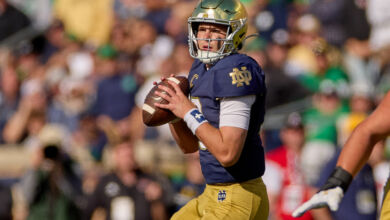
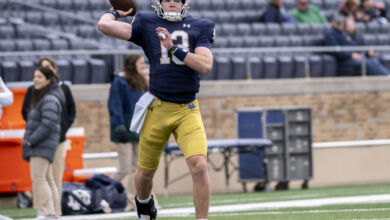
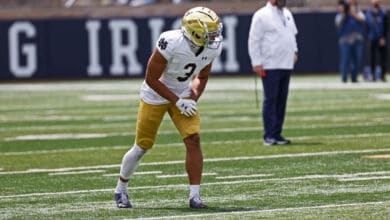
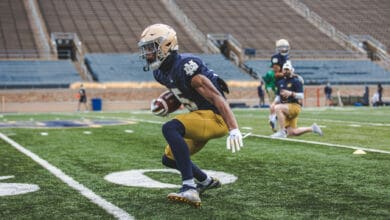
If the line is as good as advertised can we please make a commitment to the running game (hello Coach Kelly).
Jack that’s an interesting point, and I thought about analyzing the opponents, but thought it would be too speculative and arcane.
In the first four, Navy was a weak D, Michigan and Michigan State stout on D, and Purdue played surprisingly well against us. What percent was Purdue’s D and what per cent was the theory that Golson was just figuring it out?.
In the last 8 games of 2012, Stanford, BYU and USC were sound defenses, and Boston College wasn’t bad.
But that is mere information on the issue you raise, not dispositive of it.
I agree on the O Line. Just ask yourself, where would Mike Golic be on this depth chart? The Hiestand recruits, screened for mauling,
are starting to filter into the lineup. While hope is not a strategy, I have hope!
Remember, defense wins the big games. Should be an exciting year but
linebacker are a legit concern. Secondary should be better.
I only disagree with one thing, the offensive numbers in October/November of 2012 were related to weak opponents. Gilson or Zaire will make the Irish better in the redzone, but the offensive line is the key to success if the Irish want to be dominant on offense. They need to maul opposing lines and under Kelly I only saw that a couple of times. I want to see a good push from this line. If that happens ND will do fine
Even the depth issues at QB and TE are mostly about experience.
Both positions will be backed up by four-star recruits. In leaner years, we would be happy to have top-rung starters with such high-potential backups.
Most college football fans no doubt associate the Irish with a tedious, limited, excruciating offense. That’s mostly what they have seen on the field. Notre Dame’s growing arsenal of offensive weapons was unused due to limitations at the QB position. I anticipate a season of dropped jaws.
Scoring 31
And still the Irish aren’t done
Will be much more fun
This could be the start of quite a run.
Expecting Brindza will do a lot more kicking for PATs rather than FGs,
and he or Newsome becomes the least used punter in the land.
Hey Mike, we all appreciate the catchy little jingle you came up with but is it really necessary to post it every time?
Do you really want to be lumped in with the likes of:
bj = where’s the offense?
HURLS = NotaDame (I’m from Boston hence the spelling)
Ron Burgundy = stay classy
Wait that last one was mine.
Jingles?
Did someone say jingles?
My fav is…”Sometimes you feel like a nut, but when you say Bud, you say Mmmm good to the last drop”
Merry New Year!
@ Ron
It’s certainly not necessary.
As long as I get the credit for it when:
scoring 31
and still the Irish aren’t done
becomes much more fun..
Sorry- couldn’t resist.
Stay classy!